Search results
Author(s):
Michael Hoebartner
,
Philipp Kiefer
,
Michael Andrew Borger
,
et al
Added:
3 years ago
Mitral valve regurgitation (MR) is frequently induced by degenerative mitral valve (MV) disease and leads to leaflet prolapse. Therefore, valve repair is a well-proven surgical technique with excellent long-term outcomes.1–5 The risk of declining left ventricle (LV) function or LV enlargement and the development of atrial fibrillation or severe pulmonary hypertension due to chronic volume…
View more
Author(s):
Pierluigi Costanzo
,
Paul Bamborough
,
Mark Peterson
,
et al
Added:
1 year ago
Added:
3 years ago
Source:
Edwards
FT. LAUDERDALE, FL, January 30, 2012 -- Edwards Lifesciences Corporation (NYSE: EW), the global leader in the science of heart valves and hemodynamic monitoring, announced today that new data were presented on high-risk surgical patients with severe aortic stenosis treated with transapical transcatheter aortic valve replacement (TAVR) during the continued access period of Cohort A of The PARTNER…
View more
Quality of Life and Economic Analyses of Edwards SAPIEN Valve in High-Risk Patients Featured at TCT
Added:
3 years ago
News
Transseptal Mitral Valve Therapy
Author(s):
Marvin H Eng
,
Dee Dee Wang
Added:
3 years ago
Article
Author(s):
Pavel Overtchouk
,
Thomas Modine
Added:
3 years ago
This article aims to provide an updated comparative review, addressing the respective strengths and weaknesses of different alternative transcatheter aortic valve implantation (TAVI) approaches.
The transfemoral (TF) access is favoured by international guidelines on TAVI because of its reported superiority to the transthoracic approach.1–3 In spite of the progress in miniaturisation of new…
View more
Author(s):
Roberto Spina
,
Chris Anthony
,
David WM Muller
,
et al
Added:
3 years ago
Transcatheter aortic valve replacement (TAVR) with either the balloonexpandable Edwards SAPIEN XT valve (Edwards Lifesciences, Irvine, California), or the self-expandable CoreValve prosthesis (Medtronic, Minneapolis, Minnesota) has become the established therapeutic modality for severe aortic valve stenosis in patients who are not deemed suitable for surgical intervention due to excessively high…
View more
Author(s):
Alia Noorani
,
Vinayak Bapat
Added:
3 years ago
Transcatheter aortic valve implantation (TAVI) is an established alternative to surgical valve replacement in the management of calcified severe aortic stenosis in those with co-morbidities or adverse features (advanced age, impaired left ventricular function), or in those where open surgery may be associated with unfavourable technical features, such as previous sternotomy with a patent internal…
View more
Author(s):
Eden C Payabyab
,
Lindsay S Elbaum
,
Navneet Sharma
,
et al
Added:
2 years ago
Transcatheter Aortic Valve Implantation for Severe Aortic Stenosis - Overcoming the Challenges
Author(s):
Thomas Walther
,
Johannes Blumenstein
Added:
3 years ago
Article














